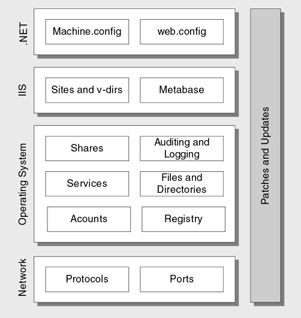Methodology for Securing Your Web Server
To secure a Web server, you must apply many configuration settings to reduce the server's vulnerability to attack. So, how do you know where to start, and when do you know that you are done? The best approach is to organize the precautions you must take and the settings you must configure, into categories. Using categories allows you to systematically walk through the securing process from top to bottom or pick a particular category and complete specific steps.
Configuration Categories
The security methodology in this chapter has been organized into the categories shown in Figure 16.2.

Figure 16.2: Web server configuration categories
The rationale behind the categories is as follows :
-
Patches and Updates
Many security threats are caused by vulnerabilities that are widely published and well known. In many cases, when a new vulnerability is discovered , the code to exploit it is posted on Internet bulletin boards within hours of the first successful attack. If you do not patch and update your server, you provide opportunities for attackers and malicious code. Patching and updating your server software is a critical first step towards securing your Web server.
-
Services
Services are prime vulnerability points for attackers who can exploit the privileges and capabilities of a service to access the local Web server or other downstream servers. If a service is not necessary for your Web server's operation, do not run it on your server. If the service is necessary, secure it and maintain it. Consider monitoring any service to ensure availability. If your service software is not secure, but you need the service, try to find a secure alternative.
-
Protocols
Avoid using protocols that are inherently insecure. If you cannot avoid using these protocols, take the appropriate measures to provide secure authentication and communication, for example, by using IPSec policies. Examples of insecure , clear text protocols are Telnet, Post Office Protocol (POP3), Simple Mail Transfer Protocol (SMTP), and File Transfer Protocol (FTP).
-
Accounts
Accounts grant authenticated access to your computer, and these accounts must be audited . What is the purpose of the user account? How much access does it have? Is it a common account that can be targeted for attack? Is it a service account that can be compromised and must therefore be contained? Configure accounts with least privilege to help prevent elevation of privilege. Remove any accounts that you do not need. Slow down brute force and dictionary attacks with strong password policies, and then audit and alert for logon failures.
-
Files and Directories
Secure all files and directories with restricted NTFS permissions that only allow access to necessary Windows services and user accounts. Use Windows auditing to allow you to detect when suspicious or unauthorized activity occurs.
-
Shares
Remove all unnecessary file shares including the default administration shares if they are not required. Secure any remaining shares with restricted NTFS permissions. Although shares may not be directly exposed to the Internet, a defense strategy ” with limited and secured shares ” reduces risk if a server is compromised.
-
Ports
Services that run on the server listen to specific ports so that they can respond to incoming requests . Audit the ports on your server regularly to ensure that an insecure or unnecessary service is not active on your Web server. If you detect an active port that was not opened by an administrator, this is a sure sign of unauthorized access and a security compromise.
-
Registry
Many security- related settings are stored in the registry and as a result, you must secure the registry. You can do this by applying restricted Windows ACLs and by blocking remote registry administration.
-
Auditing and Logging
Auditing is one of your most important tools for identifying intruders, attacks in progress, and evidence of attacks that have occurred. Use a combination of Windows and IIS auditing features to configure auditing on your Web server. Event and system logs also help you to troubleshoot security problems.
-
Sites and Virtual Directories
Sites and virtual directories are directly exposed to the Internet. Even though secure firewall configuration and defensive ISAPI filters such as URLScan (which ships with the IISLockdown tool) can block requests for restricted configuration files or program executables, a defense in depth strategy is recommended. Relocate sites and virtual directories to non-system partitions and use IIS Web permissions to further restrict access.
-
Script Mappings
Remove all unnecessary IIS script mappings for optional file extensions to prevent an attacker from exploiting any bugs in the ISAPI extensions that handle these types of files. Unused extension mappings are often overlooked and represent a major security vulnerability.
-
ISAPI Filters
Attackers have been successful in exploiting vulnerabilities in ISAPI filters. Remove unnecessary ISAPI filters from the Web server.
-
IIS Metabase
The IIS metabase maintains IIS configuration settings. You must be sure that the security related settings are appropriately configured, and that access to the metabase file is restricted with hardened NTFS permissions.
-
Machine.config
The Machine.config file stores machine-level configuration settings applied to .NET Framework applications including ASP.NET Web applications. Modify the settings in Machine.config to ensure that secure defaults are applied to any ASP.NET application installed on the server.
-
Code Access Security
Restrict code access security policy settings to ensure that code downloaded from the Internet or intranet have no permissions and as a result will not be allowed to execute.
EAN: 2147483647
Pages: 613